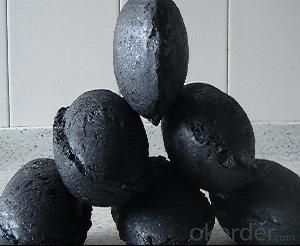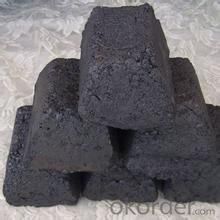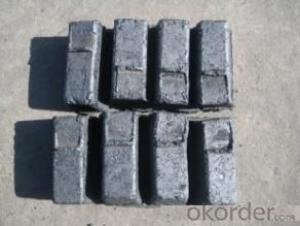Carbon Electrode Paste with low Ash 4-7%
- Loading Port:
- Tianjin
- Payment Terms:
- TT OR LC
- Min Order Qty:
- 20 m.t.
- Supply Capability:
- 3000 m.t./month
OKorder Service Pledge
OKorder Financial Service
You Might Also Like
Spcifications
1:carbon eletrode paste
2:for ferroalloy,calcium carbide manufacture
3:HS 3801300000,YB/T5212-1996,ISO9001:2008
Product Description
Carbon Electrode Paste is a self-baking electrode used in submerged arc furnaces for delivering power to the charge mix. Electrode Paste is added to the top of the electrode column in either cylindrical or briquette form. As the paste moves down the electrode column the temperature increase causes the paste to melt and subsequently bake forming a block of electrically conductive carbon. Electrode Paste is essentially a mix of Electrically Calcined Anthracite (ECA) or Calcined Petroleum Coke (CPC) with Coal Tar Pitch.
Graphite/Carbon Electrode Paste Specification:
PARAMETER UNIT GUARANTEE VALUE
Ash.( % ) 4.0 max5.0 max 6.0 max 7.0 max 9.0 max11.0 max
V.M (%) 12.0-15.512.0-15.5 12.0-15.5 9.5-13.5 11.5-15.511.5-15.5
Compress Strength. 18.0 min17 min 15.7 min 19.6 min 19.6 min19.6 min
Specific Resistance 65 max68 max 75 max 80 max 90 max90 max
Bulk Density 1.38 min1.38 min1.38 min 1.38 min 1.38 min1.38 min
Picture:


- Q:Yes, I have a weapon, want to strengthen 11, said to be advanced furnace rock carbon, do not know how to get, look at the prawns pointing
- Pro, tell you an unfortunate news, out of the eighty furnace rock carbon, old horse recycling, burning their own boilers, and now we strengthen the use of colorless small crystal block, that is, the colorless small crystal block instead of the original furnace rock carbon.
- Q:What is carbon nanoelectrode?
- A carbon nanoelectrode is a type of electrode that is made from carbon-based materials, typically in the form of a nanotube or nanowire. These electrodes are extremely small, with diameters on the nanoscale, typically ranging from a few to a few hundred nanometers. Carbon nanoelectrodes have unique properties that make them highly desirable for use in various applications, particularly in the field of electrochemistry. Due to their small size, they offer a large surface area to volume ratio, which allows for enhanced sensitivity and improved electrochemical performance. The carbon nanoelectrodes also possess excellent electrical conductivity and mechanical strength, making them ideal for use in miniaturized electronic devices and sensors. They can be easily integrated into various platforms, such as microfluidic systems or biosensors, enabling efficient and accurate detection of chemical or biological species. Moreover, carbon nanoelectrodes have shown great potential in energy storage devices, such as supercapacitors and batteries, due to their high electrical conductivity and large surface area, which facilitate rapid charge and discharge rates. Overall, carbon nanoelectrodes represent a promising advancement in the field of nanotechnology, offering unique properties and unparalleled performance for various applications in electronics, sensing, and energy storage.
- Q:Is carbon monoxide good for people?
- No good, generally will cause poisoning, gas poisoning is actually carbon monoxide poisoning
- Q:What role does carbon play in photosynthesis?
- The role of carbon in photosynthesis is crucial because it serves as the primary element utilized by plants to generate organic compounds. In the process of photosynthesis, plants absorb carbon dioxide from the atmosphere and employ it to synthesize glucose, a simple sugar that acts as a foundational component for more intricate carbohydrates like starch and cellulose. This entire process takes place within the chloroplasts of plant cells, specifically in the stroma of the chloroplast. It is in this location that the enzyme RuBisCO facilitates the fixation of carbon dioxide into an organic molecule called PGA (phosphoglycerate). By means of a series of reactions referred to as the Calvin cycle, PGA is transformed into glucose, which can be either stored as energy or utilized for growth and reproduction. To sum up, carbon is indispensable to photosynthesis since it supplies the necessary raw material for plants to self-generate their own sustenance and maintain life.
- Q:What are the applications of graphite in industry?
- Graphite has various applications in the industry due to its unique properties. It is commonly used as a lubricant in machinery and equipment due to its low friction coefficient. Graphite is also used as an electrode material in batteries, as it can store and release electrical energy efficiently. Additionally, it is used in the production of crucibles, refractory materials, and foundry molds due to its high heat resistance. Graphite is also utilized in the manufacturing of steel and other metals, as it acts as a carbon additive to improve their strength and durability.
- Q:What are the health effects of carbon monoxide poisoning?
- Carbon monoxide (CO) poisoning can have severe health effects. When inhaled, carbon monoxide displaces oxygen in the bloodstream, leading to oxygen deprivation in vital organs. Symptoms range from mild, such as headaches and dizziness, to more severe, including confusion, loss of consciousness, and even death. Prolonged exposure to high levels of carbon monoxide can result in long-term neurological damage or cardiac complications. Therefore, it is crucial to have carbon monoxide detectors in homes and ensure proper ventilation to prevent poisoning.
- Q:Where are carbon fiber sheets and carbon fiber sheets used?
- Carbon fiber and carbon fiber cloth, carbon fiber cloth, carbon fiber woven cloth, carbon fiber prepreg, carbon fiber cloth, carbon cloth, carbon fiber fabric, carbon fiber, carbon fiber sheet (prepreg) etc.. Carbon fiber reinforced fabric is one kind of unidirectional carbon fiber reinforced product, usually made of 12K carbon fiber silk fabric. To reinforce the structure of the tensile and shear strength and seismic carbon fiber cloth, the supporting material and impregnated together using a carbon fiber composite material, carbon fiber cloth sheet excellent performance can be enhanced to form a complete system, suitable for processing the building load increasing, the engineering function change, material aging, concrete strength grade is lower than reinforcement design, structure crack treatment, environment protection and repair service component.Carbon fiber board 1) Aerospace: airframe, rudder, rocket engine shell, missile diffuser, solar panel, etc.;2) sports equipment: auto parts, motorcycle parts, fishing rods, baseball bats, skis, boats, badminton rackets and so on;3) industry: engine parts, concrete structures, reinforced materials, fan blades, transmission shaft, and electrical components and so on;4) fire: suitable for army, fire fighting, steel mills and other special high-grade fireproof clothing production.Fire rating: Class A - non flammable, standard GB8624-2006, German standard DIN4102, A1 classCivil buildings, bridges, tunnels, earthquake, reinforced concrete structure, reinforcing material for reinforcement structure, tensile shear and seismic carbon fiber cloth, the use of common materials and supporting adhesive, constitute a complete performance excellence with carbon fiber cloth material reinforcing system. The system is suitable for beams, columns, slabs, tunnels, circles, arcs, etc..
- Q:What is the carbon content of different types of soil?
- Various factors, such as climate, vegetation, and land management practices, can greatly influence the carbon content of different types of soil. Generally, soils with higher levels of organic matter exhibit higher levels of carbon. For instance, peat soils boast the highest carbon content among all soil types, ranging from 30% to 60%. These soils form in wetland areas where the decomposition of organic matter is hindered by water saturation, resulting in the accumulation of substantial amounts of carbon over time. Forest soils also tend to possess relatively high carbon content, typically falling between 1% and 10%. Forests continually supply organic matter through litterfall, contributing to the build-up of carbon in the soil. In contrast, agricultural soils generally exhibit lower carbon content compared to peat or forest soils. Factors such as crop rotation, organic amendments, and tillage practices influence the carbon content of agricultural soils. Consequently, the carbon content in these soils can range from less than 1% to around 6%. Grassland soils may have carbon contents similar to agricultural soils, depending on management practices. However, in undisturbed grasslands with high plant productivity, the carbon content can be relatively higher, ranging from 2% to 8%. In arid and desert regions, soils tend to display lower carbon content due to limited vegetation and slower rates of organic matter decomposition. Typically, the carbon content in these soils is less than 1%. It is important to acknowledge that these ranges are generalizations, and the carbon content of soil can vary both within and between soil types. Additionally, alterations in land use, such as deforestation or the conversion of grasslands to agriculture, can have a significant impact on soil carbon content.
- Q:What is carbon fiber reinforced polymer?
- Carbon fiber reinforced polymer (CFRP) is a composite material made up of carbon fibers embedded in a polymer matrix. It combines the high strength and stiffness of carbon fibers with the lightweight and corrosion-resistant properties of the polymer matrix. CFRP is widely used in various industries, including aerospace, automotive, and sporting goods, due to its exceptional strength-to-weight ratio and superior mechanical properties.
- Q:Search for a summary of the importance of carbon in life. If you write well, you can add points,
- Carbon is a nonmetallic element, whether it is carbon of single substance or carbon compound. It plays an indispensable role in material production, daily life and human existenceThe material containing carbon elemental state are mainly coal, charcoal, graphite and diamond; coal, charcoal is agent or reducing domestic and industrial fuel, raw materials, graphite pencil electrode materials and high temperature resistant materials, diamond is expensive jewelry materials and industrial superhard materials.
1. Manufacturer Overview |
|
|---|---|
| Location | |
| Year Established | |
| Annual Output Value | |
| Main Markets | |
| Company Certifications | |
2. Manufacturer Certificates |
|
|---|---|
| a) Certification Name | |
| Range | |
| Reference | |
| Validity Period | |
3. Manufacturer Capability |
|
|---|---|
| a)Trade Capacity | |
| Nearest Port | |
| Export Percentage | |
| No.of Employees in Trade Department | |
| Language Spoken: | |
| b)Factory Information | |
| Factory Size: | |
| No. of Production Lines | |
| Contract Manufacturing | |
| Product Price Range | |
Send your message to us
Carbon Electrode Paste with low Ash 4-7%
- Loading Port:
- Tianjin
- Payment Terms:
- TT OR LC
- Min Order Qty:
- 20 m.t.
- Supply Capability:
- 3000 m.t./month
OKorder Service Pledge
OKorder Financial Service
Similar products
New products
Hot products





























